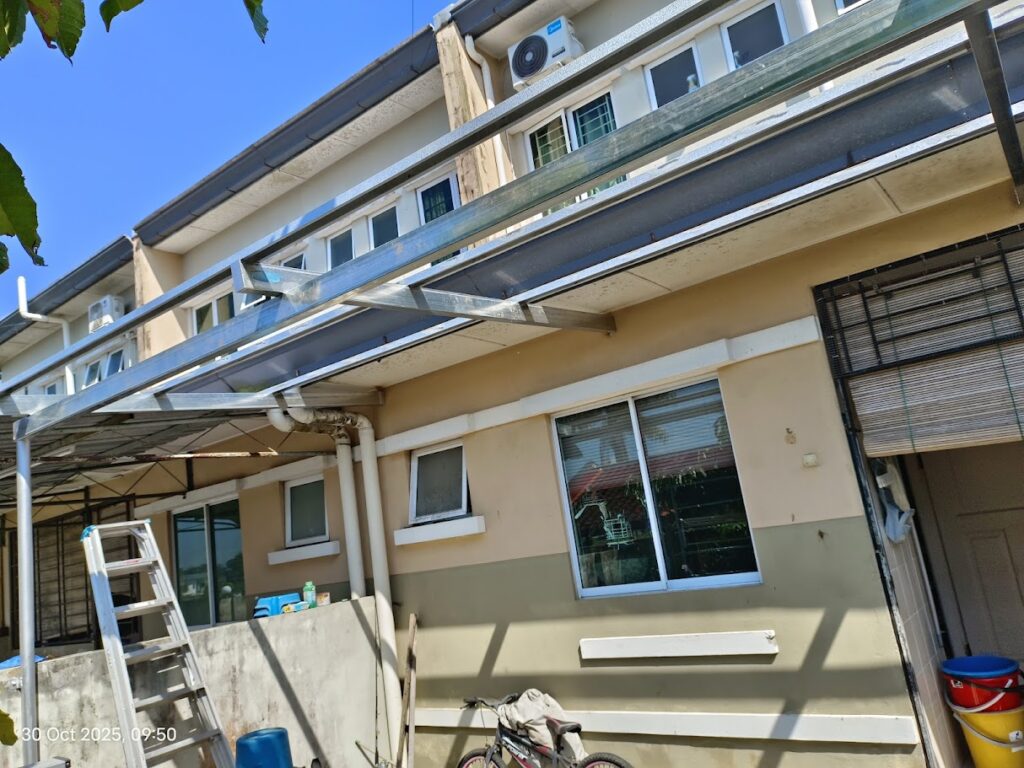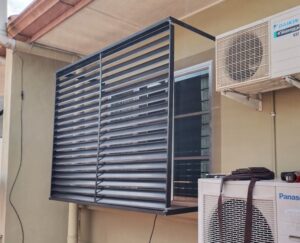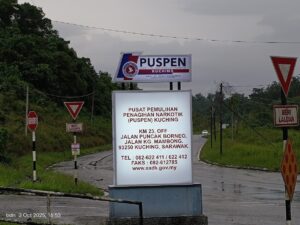How much it cost?
Basic cost is RM15 x square feet. But as usual, we can’t stand by this pricing as when the work is on going, the house owner will always instruct workers to do this and that beyond their original scope of works. In this Awning Installation, it is common that the house owner will instruct the workers to clear their gutter, clear other refuse on their house. Sometimes do little little thing that consumes the workers time. So you will have to add either fix amount or increase the RM per square feet to cater any miscellaneous costs.

Materials Used
- Main Frame
- Material: Galvanized steel rectangular hollow section (RHS) or C-channel.
- Purpose: Structural skeleton for the awning — provides support and alignment for roofing sheets.
- Common Size: 2”x4” or 1½”x3” RHS, depending on span and load.
- Roofing Sheets
- Type: Spandek or Trimdek profile metal sheets.
- Thickness: G28–G30 (lightweight but still durable).
- Material: Galvanized or zincalume-coated steel, sometimes with color coating.
- Width: Approx. 2.5 ft per sheet, flexible in length (cut-to-size).
- Installation: Laid on top of the frame with side overlaps, fastened using self-drilling screws with rubber washers.
- Fasteners
- Type: Self-tapping / self-drilling roofing screws.
- Common Issue: Incorrect screw type or poor alignment leads to leaks or sheet movement.
- Support Columns
- RHS size as frame, bolted or welded to floor base plates.
- End Support: – 2 Poles as the wind and rain nowadays is unpredictible strong and heavy.
⚠️ Potential Issues During or After Installation
- 🔧 Structural Alignment & Drainage Slope
- The frame must have a slight slope (minimum 5°–10°) for water runoff.
- Without a gutter, rainwater will cascade directly off the edge, splashing onto own ground in teh same compound.
- Risk: Over time, the drip zone could stain or erode paint/plaster near the wall base.
- 🧩 Sheet Overlap & Fastening
- If overlaps are too narrow or screws are overtightened, leakage or sheet warping can occur.
- In Kuching’s high humidity, screw corrosion or rubber washer hardening can lead to leaks after 1–2 years.
- 🌬️ Wind Uplift
- Terrace backyards can act like wind tunnels.
- If end caps or anchor points aren’t strong enough, a strong wind can lift or bend the sheets.
- Adding side flashing or wind braces helps reduce this risk.
- 🧱 Wall Connection Point
- The joint between the wall and top beam is critical.
- If not sealed properly (using silicon sealant or flashing), rainwater can seep behind the frame, staining the wall or causing ceiling dampness inside.
- ⚡ Electrical / Drainage Obstructions
- Contractors must plan so that the awning frame doesn’t block pipe maintenance access or trap condensation water under the sheet.
- 🧍 Worker Safety & Ladder Use
- The worker stands on a lightweight aluminum ladder without full scaffolding.
- While common, it’s risky especially when handling long metal sheets. A small misstep can cause a fall or the sheet edge to cut skin.
💬 Additional Notes (Specific to Kuching Conditions)
- Humidity & Rust: Even with galvanization, surface rust can appear after a few years due to sea air and high rainfall. Applying anti-rust primer or cold galvanizing spray at weld joints helps.
- Noise: Spandek amplifies rain noise; homeowners often underestimate this until the first heavy downpour.
- Heat: Without insulation or ceiling panels, the area below will trap heat during midday sun


